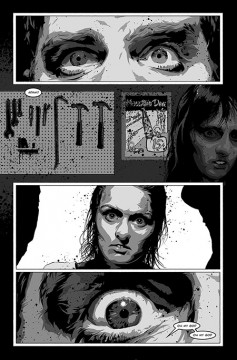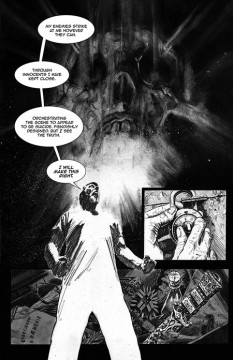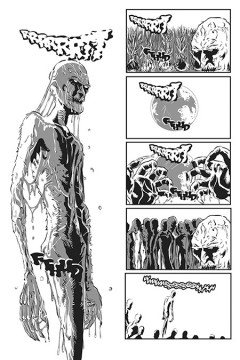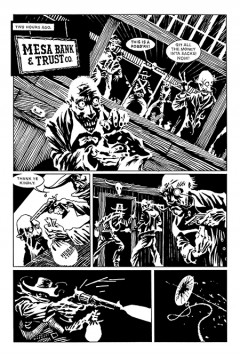“A horror comic is like a delicate piece of music” writer Sam Costello on the subtleties of scaring people in the Split Lip Horror Comics Anthology
 We love a good scare at Pipedream Comics, and one series which has really unsettled us in recent times has been the Split Lip Horror Comic Antholology. A new discovery for us here in the UK, it has a well-established pedigree in the US and some of the scariest stories are being collected into an anthology via Kickstarter. We catch up with creator Sam Costello to find out what has inspired him to keep freaking people out after a decade of Split Lip.
We love a good scare at Pipedream Comics, and one series which has really unsettled us in recent times has been the Split Lip Horror Comic Antholology. A new discovery for us here in the UK, it has a well-established pedigree in the US and some of the scariest stories are being collected into an anthology via Kickstarter. We catch up with creator Sam Costello to find out what has inspired him to keep freaking people out after a decade of Split Lip.

For readers here in the UK can you tell us a bit about Split Lip? What was the inspiration behind it and how did you start publishing comics online and then collect them into this volume?
Sam Costello: I’ve wanted to make comics for a long, long time. I have a vivid memory of riding in the car with my mom when I was 10 or 11 and talking about wanting to work on X-Men when I grew up. Comics and I drifted apart during my teens, but a friend got me back into them around the end of college. I was writing a lot of fiction then and started to think about writing comics.
I wasn’t making much headway trying to place 8-page stories in anthologies. One holiday I was watching a Twilight Zone marathon on TV and the idea struck me: there should be a comics equivalent of Twilight Zone (little did I know there had been a number of them). I didn’t do anything immediately, but the idea stuck with me. A few years later, I was tired of trying to land stories in anthologies, remembered the idea, and got to work on Split Lip.
Publishing on the web was the only way to go at that time. Print was too expensive and I was working at a web development company, so I knew enough about what was required to get things off the ground. Plus, putting stories online would let me attract a larger audience, which was my only goal when I started Split Lip: get my comics read.
Later, as I started to think about going to conventions and trying to make a little money, collecting stories into books was the natural next step. Since then, I’ve published 6 books collecting 40+ Split Lip stories, as well as 8 minicomics with 1 or 2 stories each.

Judging by the intros to each chapter you see to be a real horror aficionado, which books, films or writers are the inspirations or touchstones for your work?
SC: In the last few years, I’ve really been taken with comics work by Emily Carroll, Josh Simmons, Julia Gfrorer, Naoki Urasawa, and Tom Neely. I think a lot about movies like At The Devil’s Door, which was directed by Nicholas McCarthy, and TV shows like Hannibal and This American Life. I haven’t been reading as much fiction as I should these days, but short story writers like Dan Chaon and Brian Evenson are automatic purchases for me, and no novel has stayed with me as powerfully and vividly as Ryan Gattis’ Rodney King riots-era LA story, All Involved.
My longer-term, foundational influences include Barker, Lovecraft, Craven, Joyce Carol Oates, Grant Morrison, Alan Moore, Neil Gaiman, J-Horror, the EC Comics artists, Junji Ito, Kazuo Umezu, Suehiro Maruo, and others.
10 years is quite a long time for an indie self-publisher, what do you put your longevity down to? Have there been many ups and downs along the way?
SC: A friend of mine once said I’m the kind of person who can’t not work on a project. I just have a need to work on things and when I commit to something, it just becomes a part of my life. That’s not to say there haven’t been periods of inactivity. I ended Split Lip for about 18 months between 2012 and 2014. I was burned out and disappointed by failing to live up to unrealistic expectations I’d set for myself. When I gave myself some time off, stories started to bubble up again and I realized they were Split Lip stories and the series would return. Honestly, I think there’s a chance that I’ll be writing Split Lip for much of the rest of my life (though hopefully it’s not the only thing I write!).

The black and white artwork gives it a really unique feel, why choose that format? Was it a stylistic choice or a cost choice?
SC: Very much a stylistic choice (it doesn’t hurt that printing in black and white is much, much cheaper than colour, but that didn’t drive the decision). Colour is a dangerous thing for horror comics, I think. A horror comic is like a delicate piece of music. Story, dialogue, theme, tone, and art all have to work in harmony and any missed note can bring the entire thing crashing down. Too often, I think, colour in horror comics is a dissonant note, something added because it’s expected but not because it really adds to the story. Plus, there’s something about the starkness of black and white art that feels really raw and immediate, two things horror should be.
We dabbled a little bit in colour on the website – there are a few stories that have a couple of spots of red to punctuate scenes – and my view on color is evolving. I’m curious to experiment with it.
How did you connect with the various artists and how did you choose who would be right for each particular story?
SC: The connections are always due to the Internet. In the old days it was messageboards, now it’s social media and portfolio sites. I keep an eye out for artists I like and check out their work, then check out the work of artists they like or are friends with, and on and on. Eventually you collect a great big folder of links for folks you’d like to work with (that folder on my computer has almost 70 people in it right now). Some artists come to me via introductions from other artists. That’s been especially true of the UK-based artists I’ve worked with. Shane Oakley, who provides the covers to the Split Lip TPBs, who introduced me to Gary Crutchley and David Hitchcock (thanks again, Shane!).
Matching artists and stories is an art in its own right. Partly it’s a matter of looking at the artist’s previous work and seeing what they’re best at drawing, but there’s also the tone that their work conveys. If you can match the tone of an artist’s work with the tone of the story, you’re likely going to get a good result.

One good example of this in the 10th anniversary anthology is Unsub (http://www.splitlipcomic.com/comic/unsub-pg1/), which is drawn by T.J. Kirsch. T.J. is really adept at conveying subtle, powerful emotions in characters. He’s got a command of body language and facial expression. Unsub was the perfect venue for that. It’s a story that takes place almost entirely in the interrogation room of a police department and is mostly a conversation between a detective and a woman who’s not sure why she’s been called in. The art needs to convey bewilderment, curiosity, shock, and sadness and do it mostly in faces. An artist whose greatest strength is double-page action spreads or monster design wouldn’t be a good match, but with his mastery of facial expression and the nuances of human interaction, T.J. was perfect for it.
How did you pick which Spilt Lip stories would appear in the collected volume and were they any that didn’t quite make the grade which you are sad didn’t make it it?
SC: When planning the 10th anniversary anthology, my partner suggested that I organize the book around the series’ major themes. Her suggestions are virtually always right when it comes to my comics and I’ve learned to shut up and listen to her. I concluded that Split Lip’s major themes were the Supernatural, Monsters and Creatures, Tragedies, and Hell Is Other People. Then it was just a matter of finding the stories that best illustrated Split Lip’s handling of those themes.
I easily could have made the book another 300 pages long. I briefly toyed with the idea of doing a 700-page omnibus or a multi-volume set, but both seemed a little too ambitious. The Split Lip archives are packed with great stories working through these themes, and others, and I expect there will be future deluxe collections. In the meantime, the entire series is available in TPBs (save two stories which will show up in the next book).

How important has the growth of digital comics been for you as a webcomic publisher, or are you more old school in your approach?
SC: In terms of drawing an audience to the comics, digital is truly the only means for an indie like me to find an audience these days. Split Lip has been free to read on the web since 2006. The ease of access definitely allows me to draw a good audience—tens of thousands of people this year alone, and we’re on track for the most readers in the site’s history. If it weren’t for the web and powerful, simple publishing tools – WordPress, the ComicEasel webcomics framework (http://frumph.net) written by Philip Hofer – I don’t imagine Split Lip would still be around.
Digital has been crucial in terms of generating sales, too, particularly with comiXology. I’ve got a pretty busy schedule outside of comics, so I can only attend 2-4 comic conventions a year – and even then, I tend to stick to conventions in the Northeast part of the U.S., where I live. Even if those conventions are absolute gangbusters, I probably only get books into the hands of a couple of hundred people a year. That number is matched in good three months on comiXology. That means a lot for keeping the series going, increasing readership, and paying royalties to the artists.
What do you think makes Split Lip stand out from the other black and white horror anthologies out there?
SC: The top-notch writing, of course! Seriously, though, I think – I hope! – Split Lip stands out thanks to its art, its approach to the subject matter, and its variety. The art speaks for itself. I’m lucky to work with amazing artists from all around the world. Without them there would be no Split Lip. The range of styles on display in Split Lip makes it a lot of fun, as does the very high quality of the art. It’s no surprise to me that a number of these artists have gone on to do books for Image, IDW, Selfmade Hero, and others.
I strive, also, to approach the genre from new angles. There are places for vampires and zombies and werewolves and other archetypal monsters and I like works that feature all of them. I just don’t think their place is in Split Lip. I want Split Lip to look for new and unusual approaches to the genre. I want it to spend as much time presenting well-rounded, lived-in characters as it does frightening or killing them. I want to elicit emotions other than fear or dread (though those are on my agenda, too!). I hope to find like-minded readers and artists who want the same thing for another 10 years.
For more info visit www.splitlipcomic.com to read more of Sam’s series.
And if you want to back the Split Lip Anthology on Kickstarter, be sure to pick our Pipedream Comics exclusive pledge which give you reduced shipping to the UK for a limited number of pledgers!


